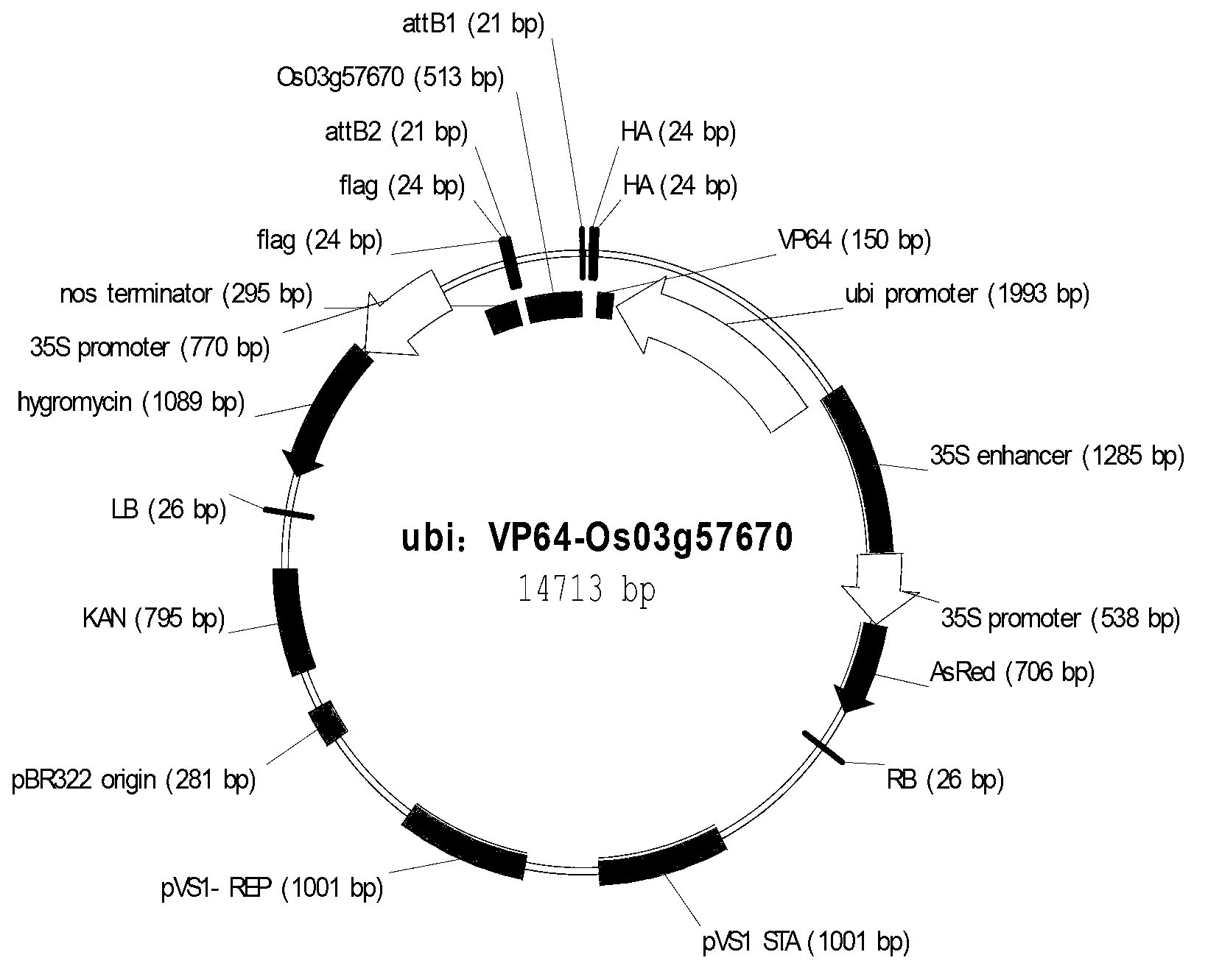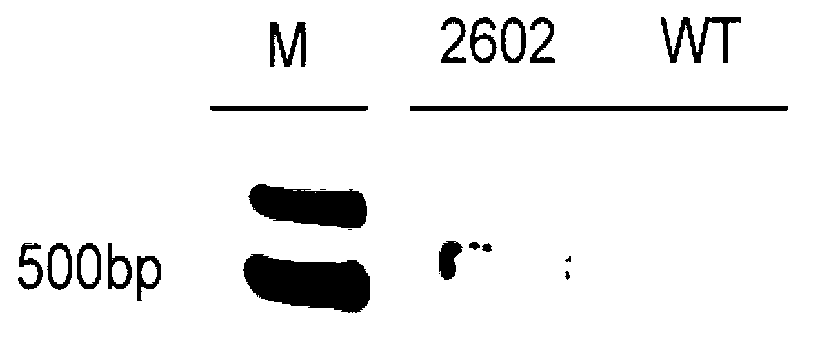Application of synthetic transcription factor VP64-Os03g57670
A technology of n-linker-os03g57670, os03g57670-linker-, which is applied in the field of genetic engineering, can solve the problems such as the change of the transgenic receptor trait and the weak effect of the transcription factor, and achieve the effect of reducing 1000-grain weight, improving the stress ability, and improving the market application value.
- Summary
- Abstract
- Description
- Claims
- Application Information
AI Technical Summary
Problems solved by technology
Method used
Image
Examples
Embodiment 1
[0035] The isolation of embodiment 1 Os03g57670 gene and the construction of plant expression vector
[0036] The Os03g57670 gene was found in the plant transcription factor database (http: / / planttfdb.cbi.edu.cn / index.php?sp=Osj), and PCR amplification primers were designed according to its sequence (forward primer F1: 5'-CAAAAAAGCAGGCTTCATGTCCCCCGGTGAGGAGGACGTGG- 3' and reverse primer R1:
[0037] 5'-CAAGAAAGCTGGGTCAGGAAACGAGAATTCAGATGCGAAG-3'. ) Using the total cDNA of wild Nipponbare rice as a template, PCR was performed to obtain the CDS sequence of the Os03g57670 gene, the nucleotide sequence of which is shown in SEQ ID NO.1.
[0038] Perform PCR according to the PrimeSTAR polymerase amplification system and reaction procedures. This process includes two rounds of PCR. The primers of the first round of PCR use the gene primers (F1 and R1) with a partial adapter attB linker, while the template of the second round uses the PCR product of the first round, and the primers u...
Embodiment 2
[0039] The acquisition of embodiment 2 transgenic rice plants
[0040] Take the mature seeds of rice 'kitaake', shell them manually or mechanically, select the plump, smooth and spot-free seeds and inoculate them on the induction medium for induction culture after being sterilized. Rice callus with good appearance and good growth was selected as the recipient material, and ubi:VP64-Os03g57670 was transferred into the rice callus by the Agrobacterium-mediated method, and acetosyringone containing 100 μM and an O.D. value of 0.7 were used. The AAM transformation liquid of Agrobacterium was transformed, and the callus soaked in the transformation liquid was placed on the co-culture medium for co-cultivation, cultured in the dark at 25°C for 3 days, then placed on the screening medium for about 30 days, and subcultured every 10 days. Then, the screened out resistant calli were transferred to the differentiation medium for differentiation for about 20 days, and subcultured every 10...
Embodiment 3
[0044] The formula of the differentiation medium is: MS inorganic + MS-B5 trace + MS organic + iron salt + MS-copper cobalt mother solution + 0.05mg / L NAA + 2.0mg / L Kinetin (kinetin) + 30g / L sorbitol + 2g / L hydrolyzed casein + 30g / L sucrose, prepared with water, adjust the pH to 5.8 and add 4g / L plant gel. Identification of embodiment 3 transgenic rice
[0045] In order to detect whether the Os03g57670 gene is integrated into the rice genomic DNA, wild-type ('kitaake') and transgenic rice leaf DNA prepared by the present invention were extracted, and a pair of primers (VP64-1F: 5'- ATGGACGCGCTGGACGATTT-3', 2602-R: 5'-AGGAAACGAGAATTCAG-3') According to the PrimeSTAR polymerase amplification system and reaction program, the transgenic plants were identified by PCR. According to the PCR results, the target band (780bp) was amplified in all the transgenic rice , but there is no band for this purpose in wild-type rice, the results are shown in image 3 . It was preliminarily de...
PUM
 Login to View More
Login to View More Abstract
Description
Claims
Application Information
 Login to View More
Login to View More - R&D
- Intellectual Property
- Life Sciences
- Materials
- Tech Scout
- Unparalleled Data Quality
- Higher Quality Content
- 60% Fewer Hallucinations
Browse by: Latest US Patents, China's latest patents, Technical Efficacy Thesaurus, Application Domain, Technology Topic, Popular Technical Reports.
© 2025 PatSnap. All rights reserved.Legal|Privacy policy|Modern Slavery Act Transparency Statement|Sitemap|About US| Contact US: help@patsnap.com



